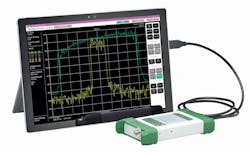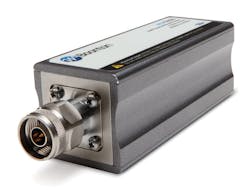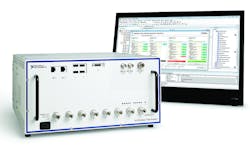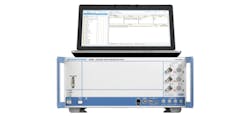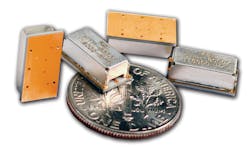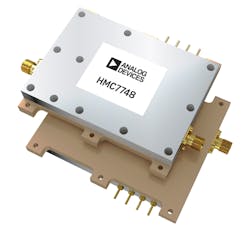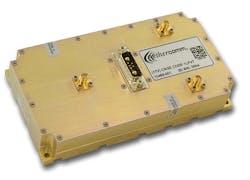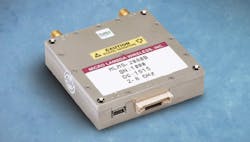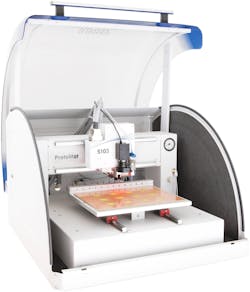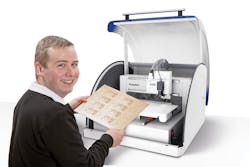Download this article as a .PDF
Smaller recent technical conferences and exhibitions have signaled a general optimism concerning the near-term business outlook for the RF/microwave industry, an optimism reminiscent of the early 1990s and the beginnings of “the wireless revolution.” Of course, those smaller shows, such as the IEEE 2017 Long Island Microwave Symposium (April 6, Hauppauge, N.Y.), are merely warmups for the one annual event that is “the granddaddy of them all”: The IEEE International Microwave Symposium (IMS).
Scheduled to take place from June 4-9, 2017 for the full conference and June 6-8, 2017 for the exhibition hall, the show planned for the vacation-like setting of Honolulu, Hi., causing some of the industry’s major players, such as Mini-Circuits, Synergy Microwave Corp., and Tektronix, to opt out. As a result, the exhibition show floor will be somewhat smaller than in years past, certainly compared to 2016’s bustling event in San Francisco. Still, the 2017 IMS Exhibition will boast booths for more than 500 RF/microwave companies, which will display enough items of interest to keep most high-frequency engineers away from the beach for at least a few days.
The 2017 IEEE IMS Exhibition show floor is a once-a-year opportunity to go shopping in real time, poring through examples of products from some of the leading designers and suppliers in the industry. While not every company is represented, and those that are may bring only a small sampling of their total product lines, it offers the chance to see what different companies make, rather than viewing images on a website.
The exhibition also provides an opportunity to interact in real time with people at various booths, perhaps gaining some knowledge that could prove invaluable. It represents the community that is the RF/microwave industry. This one time during the year, members of that community can share thoughts on some of the challenges facing the industry, such as the need for lower-cost test equipment or young RF/microwave engineers to help refresh an aging engineering community.
Testing the Waters
For many visitors to the IMS exhibition, the show floor becomes an audition space for the latest products, with firsthand looks of what is new and useful in the way of test equipment. Growing interest in millimeter-wave frequencies for applications like automotive radar systems and backhaul links in Fifth Generation (5G) wireless communications networks, coupled with projections of billions of Internet of Things (IoT) using wireless technology to pass sensor data from electronic devices to the internet, has triggered quick and dramatic changes in RF/microwave test-and-measurement equipment requirements.
On one hand, signal generators and analyzers must deliver higher-frequency coverage, well into the millimeter-wave frequency range, while lower-frequency testers must provide the flexibility to verify the performance of whatever wireless technology might be used on different IoT devices. Moreover, testing on such “commodity” RF/microwave products must be done quickly and cost-effectively.
At the same time, a good portion of the industry is still deeply involved in defense electronics work. It’s essential that legacy measurement capabilities be maintained over well-established frequency ranges, such as 10 MHz to 18 GHz. That’s because prime contractors and their vendors are working to meet military customers’ requests to upgrade and modernize many defense electronic systems, such as radar, electronic-warfare (EW), and electronic-countermeasures (ECM) systems.
The IMS exhibition floor has traditionally served as an opportunity for test-equipment suppliers to bring current customers up to date, as well as add new customers. Since the RF/microwave industry is a relatively concentrated group of companies, a test-equipment firm’s customers are often in the booth next door, since component manufacturers rely on testing to qualify their products.
As more component manufacturers attempt to support the volumes needed for high-volume IoT and higher-frequency 5G applications, their test needs will change. It becomes a no-brainer, then, for test-equipment suppliers to use events like the 2017 IEEE IMS to unveil new gear and, at the very least, query their customers on present and future measurement requirements.
For visitors interested in new test gear, Anritsu Co. (Booth 1116) will not disappoint. The company will offer demonstrations of its affordable vector network analyzers (VNAs), including the VectorStar MS4647B four-port differential system with new Universal Fixture Extraction (UFX) software. The software speeds and simplifies the process of de-embedding user-customized test fixtures from a device under test (DUT).
Engineers working on millimeter-wave devices will be drawn to Anritsu’s broadband VectorStar ME7838A system, which can perform swept-frequency VNA measurements from 70 kHz to 110 GHz in an on-wafer environment (Fig. 1). On the same probe setup will be the new 110-GHz Spectrum Master MS2760A ultra-portable spectrum analyzer directly connected to an on-wafer probe. The combined on-wafer station will display 110-GHz S-parameter measurements and 110-GHz spectral analysis for thorough device characterization.
IMS will mark the debut of the MS2760A. It is the first handheld millimeter-wave spectrum analyzer to provide continuous coverage from 9 kHz to 110 GHz, making it a cost-effective test solution for a growing number of millimeter-wave applications in automotive radar, satellite communications (satcom), 5G, and IEEE 802.11ad communications systems. The compact spectrum analyzer is powered by a Universal Serial Bus (USB) connection and controlled from a Windows-based personal computer (PC), laptop, or tablet.
Such flexibility makes the MS2760A an effective measurement solution for the laboratory, manufacturing floor, or in-field testing. Its small size and portability enable a direct connection to almost any DUT, eliminating the need for expensive and lossy coaxial test cables or antennas. Anritsu will also show its new Power Master MA24507A frequency-selectable millimeter-wave power analyzer, in support of affordable, portable power measurements at millimeter-wave frequencies.
In keeping with the need for more affordable measurements, Copper Mountain Technologies (Booth 1940) will demonstrate its line of compact, USB-driven VNAs, including the S5048 with frequency range from 20 kHz to 4.8 GHz (Fig. 2). This simple but accurate two-port VNA is capable of measuring forward and reverse S-parameters for S21, S12, S11, and S22. It provides a wide output-power range from ‒50 to +5 dBm and an even wider measurement dynamic range of 123 dB for a 10-Hz intermediate-frequency (IF) bandwidth.
This may be one of the simplest RF/microwave instruments to connect, since the control and processing is performed by a companion PC with USB port. The front panel contains the two test ports and a power switch, while the rear panel has the USB port, power receptacle, external trigger port, and connector for an external 10-MHz reference oscillator.
In spite of the unassuming appearance, the S5048 VNA provides full-sized performance, using software running on a Windows PC. It can be used with multiple precision calibration methods and automatic calibration techniques, and can record as many as 200,001 measurement points, with measurement speed of 250 μs/point. The software provides a great deal of flexibility in terms of data processing—up to 16 data traces per channel window—with the capability to store and analyze data in the frequency and time domains. For those in need of higher-frequency measurements, Copper Mountain Technologies will undoubtedly display and demo its 6.5-GHz S5065 VVA and 8.5-GHz S5085 VNA at IMS.
Use of a PC and dedicated software as the measurement controller is a growing trend for RF/microwave measurements. On that front, visitors to Boonton Electronics (Booth 1209) will have the chance to learn more about its RTP5000 real-time peak power sensors (Fig. 3) and Real Time Power Processing technology. In contrast to conventional serial power measurements, this technology is based on multiple, parallel measurements of power for the capture of any short-duration events.
The compact RTP5000 power sensors can perform 100,000 measurements per second with bandwidths as wide as 195 MHz and single-shot bandwidths of 35 MHz, and maintain a 100-Msample/s continuous sample rate and 10-Gsample/s effective sample rate. Power sensors are available for frequency ranges of 50 MHz to 6, 18, and 40 GHz; average dynamic range is as wide as ‒60 to +20 dBm through 6 GHz and pulse dynamic range extends from ‒50 to +20 dBm through 6 GHz. The sensors connect to a PC running Boonton’s Power Analyzer Suite of software for high-speed power measurements and comprehensive follow-up power analysis.
For high-frequency device testing through sub-terahertz (sub-THz) frequencies, Cascade Microtech (Booth 1626) will demonstrate its new PM8 manual probe system. The system allows precision probe motion to 200 mm in both the x and y axes for characterization of different types of electronic devices, including optoelectronic and microelectromechanical-systems (MEMS) devices. To enhance measurement accuracy, the PM8 features high vibration resistance and active platen cooling to boost thermal stability. The modular system is suitable for manual in-process testing and failure analysis, and is supported by probe-station control software.
Making a Match
While most high-frequency engineers will need a signal generator and analyzer of some form, not everyone will need the kind of test gear displayed by Maury Microwave Corp. and Focus Microwaves, namely impedance tuners. Maury Microwave (Booth 1536) will provide examples of its precision machining capabilities, essential to many measurements at RF/microwave frequencies.
Maury’s test systems include its MT97x and MT98x series automated impedance and load-pull tuners, respectively. These tuners employ highly detailed transmission-line structures that make it possible to match the impedance of a DUT to a terminal impedance, such as when matching a source or load impedance to a high-power transistor for optimum power or a low-noise transistor for optimum noise figure. Such impedance tuners have long been vital tools in the development of active-device software models that can simulate the performance of a transistor or IC under different conditions.
Focus Microwaves (Booth 1048) will show its new MPT-110200 tuner. With three independent tuning probes, the load-pull tuner is designed to make non-50-Ω measurements from 20 to 110 GHz, in preparation for the wave of millimeter-wave components earmarked for applications from automotive radar systems to 5G backhaul links. The tuner can also be used to generate the high VSWRs needed for prematching active devices, such as transistors and ICs for optimum performance over a frequency bandwidth of interest.
One expression sure to be on the lips of many at 2017 IMS will be Internet of Things, commonly referred to as IoT. Though the market is very cost-sensitive, it is simply too large to ignore for many RF companies. As a result, many are seeking ways to competitively build and test IoT components.
Keysight Technologies (Booth 1526) will showcase its latest design, simulation, and characterization test solutions for wireless communications (5G, IoT, WLAN) and aerospace/defense (Radar, EW, Satellite). Visitors can meet Keysight’s application experts and evaluate a range of solutions in various form factors from benchtop to modular to handheld. Keysight will also be involved in various exhibitor keynotes, workshops, and technical programs.
National Instruments (Booth 740) will demonstrate its Wireless Test System (WTS) and Wireless Test Module (WTM). Based on PXI modular instrument technology and the company’s comprehensive LabView measurement software, the test system (Fig. 5) features a vector signal transceiver (VST) with as much as a 200-MHz instantaneous bandwidth from 65 MHz to 6 GHz. It has a “standard commands for programmable instruments” (SCPI) interface for remote automation over Ethernet and can handle testing for wireless standards ranging from GPS and Wi-Fi to Bluetooth, Bluetooth LE, and LTE-A cellular communications.
Top Dog Test (Booth 1932) will update visitors on its services related to test equipment, including repair, troubleshooting, and calibration for some leading equipment names, including Anritsu, Keysight, Rohde & Schwarz, and Tektronix. The firm provides sales, lease, and rental services for a wide range of measurement functions and instruments, and can help a company liquidate unneeded test equipment assets.
Rohde & Schwarz (Booth 1348) will bring a number of its high-performance test instruments to 2017 IMS, including the R&S FPC1000 spectrum analyzer that is priced for broad appeal. The general-purpose analyzer’s basic frequency range of 5 kHz to 1 GHz can be expanded to 2 or 3 GHz via software upgrades. It has a basic noise floor of typically ‒150 dBc, which can be extended to as low as ‒165 dBm with an option. The analyzer also handles input power as high as 1 W (+30 dBm) for wide-dynamic-range measurements. It shows results on a large, 10.1-in. display.
With the growing interest in IoT, it is likely that Rohde & Schwarz will also demonstrate its new R&S TS 290 IoT carrier acceptance test system (Fig. 6). The single instrument allows manufacturers of wireless IoT devices to perform wireless acceptance testing on their integrated wireless modems.
Signal Hound (Booth 1439) will unveil a sampling of its USB-powered test instruments at IMS, including its reasonably priced model USB-SA44B. Costing under $1,000, the spectrum analyzer is capable of measurements from 1 Hz to 4.4 GHz. It features a wide dynamic range of ‒151 to +10 dBm with resolution bandwidths from 0.1 Hz to 250 kHz. Based on software-defined-radio (SDR) technology, the analyzer is effective for troubleshooting and experimentation.
The Signal Hound booth will also unleash its VSG25A vector signal generator (Fig. 7), a versatile signal source with a frequency range of 100 MHz to 2.5 GHz. It features an arbitrary waveform generator (AWG) that can be clocked at any frequency from 54 kHz to 180 MHz, and can be used to produce a wide range of modulated output waveforms and multiple tones.
Holzworth Instrumentation (Booth 835) will show its phase-noise measurement instruments, including the HA7062A phase noise analyzer with noise floor below ‒190 dBc/Hz at an offset 40 MHz from the carrier. The analyzer, with a measurement range of 10 MHz to 20 GHz, and offset range of 0.1 Hz to 40 MHz, achieves high accuracy by means of an ANSI-traceable z540 calibration. In addition to real-time measurements of phase noise and jitter, the analyzer can also measure amplitude modulation (AM) and pulse modulation. It is supplied in a 1U instrument chassis for ease of installation in ATE systems.
Cruising for Components
Component miniaturization has been a common theme of recent IMS conferences and exhibitions, and the interest will likely intensify as designers attempt to boost functionality within ever smaller packages. To that end, frequency mixers—key component building blocks for communications receivers and transmitters—of the miniature variety will be on tap at Marki Microwave’s booth (Booth 1041). Marki’s MMIQ-0205HSM, a surface-mount in-phase/quadrature (I/Q) mixer for use from 1.75 to 5.0 GHz, comes in a 5- × 5-mm QFN package (Fig. 8). Suitable for radar and radio communications systems, the mixer can be used for either frequency upconversion or downconversion.
At higher frequencies, staff at SAGE Millimeter (Booth 640) will provide guidance for visitors needing to find their way around the millimeter-wave frequency bands. Among the array of active and passive components on display will be some of the firm’s latest developments, including its SBP-753-1142515-1010-E1 W-band power amplifier with +15 dBm output power and typical 25-dB gain from 75 to 110 GHz. Equipped with WR-10 waveguide and UG-387/U-M flanges, the amplifier can also be supplied with 1-mm coaxial connectors or right-angle WR-10 waveguide.
For its part of riding the 5G wave, SAGE has developed the SAR-1834031432-KF-S1-DR dual-ridged horn antenna for use from 18 to 40 GHz. It provides nominal gain from 12 to 17 dBi with typical 3-dB beamwidth between 20 and 43 deg. It uses a female K connector and supports linearly polarized waveforms.
Krytar (Booth 525) will be among the many RF/microwave component suppliers at the 2017 IMS exhibition to show greater attention to their over-30-GHz components. The company has long been a proven supplier of directional couplers and hybrids at millimeter-wave frequencies—its coaxial models are as broadband as the model 101065013, with a frequency range of 1 to 65 GHz and 13-dB coupling that is flat within ±1.5 dB across that range. It is supplied with female 1.85-mm coaxial connectors and handles as much as 20-W input power.
Representatives from K & L Microwave (Booth 1401) will be on hand to show a new line of surface-mount highpass filters with cutoff frequencies of 6 to 18 GHz. The filters (Fig. 9) guarantee rejection of 45 dB at one-half the 3-dB cutoff frequency and maximum insertion loss of 2.5 dB. The filters are housed in a compact surface-mount package measuring just 0.44 × 0.24 × 0.16 in.
Often it is the smallest components that have the biggest impact, and such is the case with a new line of capacitors. AVX Corp. (Booths 1212 and 1311) will show its new MS Series metal-oxide-semiconductor (MOS) capacitors for applications from dc to 20 GHz. The low-profile capacitors deliver temperature-stable, high-Q performance with high breakdown voltages and low leakage. Capacitance values range from 1 to 1,000 pF, and capacitance tolerances are as tight as ±0.1 pF. They come in seven standard case sizes with four standard working voltages (25, 50, 100, and 200 V).
According to Larry Eisenberger, principal technical marketing engineer at AVX, “Built to provide rugged, reliable solutions for applications in the dc to 20-GHz range, the new MS Series MOS capacitors are fabricated with unique processing procedures and material sets to achieve high Q, excellent temperature stability, high dielectric strength, high insulation resistance, and low ESR.”
Smiths Interconnect’s Tecom brand (Booth 1441) will be displaying selected high-performance airborne antennas. Among them are space-qualified antennas, including type 401163-7, which provides S-band hemispherical, broad beam pattern coverage for optimum telemetry control of a satellite in all orientations. The antenna is fully compliant for space environments, including out-gassing, severe shock, vibration, temperature, and RF requirements. The 401163-7 antenna, with its frequency range of 1800 to 2350 MHz, was selected for installation on a NASA remote-sensing and satellite program.
When visiting L3 Narda-MITEQ (Booth 1201), one can learn more about the HRT-18G fiber-optic transmitter, which turns light into a transmission line for wideband, high-data-rate communications. It is an easy-to-install module with a 3-dB bandwidth of 50 MHz to 18 GHz using a distributed-feedback (DFB) laser diode. The laser-diode transmitter, which can be used for commercial or military applications, provides a handy means of making broadband remote connections between a receiver/transmitter and a local oscillator (LO) or antenna.
Boosting Levels
The 2017 IMS exhibition floor will feature a “who’s who” collection of amplifier suppliers in almost every shape and size, from tiny ICs to massive rack-mount systems for military radar and electromagnetic-compatibility (EMC) testing. The requirements are also far-ranging, since emerging applications such as IoT devices require signal amplification with almost no current and power consumption, posing real design challenges for designers of amplifiers aimed at those applications.
AmpliTech (Booth 711) has long supplied some of the highest-performance amplifiers in the industry, whether for commercial or military use. Its customer list includes some of the top research facilities in the world and leading defense contractors. The company’s amplifiers feature some of the lowest noise figures in the industry, and are supplied with waveguide or coaxial connectors as needed.
For example, model APT4-18004000-4008-D20 is constructed to MIL-STD-883 and MIL-STD-45208 requirements for applications from 18 to 40 GHz using field-replaceable female SMA connectors. With typical noise figure of 3 dB and gain of 41 dB across that frequency range, it is well-suited for point-to-point radios and test-equipment applications in military and space environments. The gain stays flat within ±3 dB and the amplifier provides +12 dBm typical output power at 1-dB compression.
In contrast, at lower frequencies, AmpliTech’sAPTW6-07100840-50K10-WR112-D6 has WR112 waveguide input for X-band satellite-communications (satcom) applications from 7.1 to 8.4 GHz. To achieve maximum receiver sensitivity across those frequencies, this amplifier achieves a noise temperature of only 40 K (a noise figure of a mere 0.56 dB) with healthy typical gain of 63 dB across the full frequency range. The gain is flat within ±1 dB, with typical output power of +13.5 dBm at 1-dB compression.
The rugged, weatherproof amplifier is also a candidate for weather-radar, traffic-control, and law-enforcement applications. It includes an internal dc regulator and reverse-voltage protection to outlast even the clumsiest of handling.
Analog Devices (Booth 1032), well known for its tiny ICs, will also have larger components on display, including the model HMC7748 military-grade amplifier module (Fig. 10). It provides 25 W output power from 2 to 6 GHz with 58-dB small-signal gain. It draws 0.7 A current from a regulated +12-V dc supply and can be turned on and off with an external enable pin. The rugged amplifier is well-suited for military communications and radar applications, as well as for test-and-measurement systems.
Ampleon (Booth 914) will show a sampling of high-power LDMOS devices and amplifiers for commercial and military applications. Examples include an S-band amplifier capable of 400 W output power, a 900-W amplifier for UHF commercial broadcast use, and a 2-kW amplifier for ISM applications at 127 MHz. Also on display will be high-power amplifiers designed for RF heating and energy applications.
For millimeter-wave bands, Smiths Interconnect’s Millitech brand (Booth 1441) will exhibit a series of power amplifiers based on pseudomorphic high-electron-mobility-transistor (pHEMT) technology for total coverage of 18 through 110 GHz. The amplifiers achieve saturated output-power levels as high as +38 dBm at 35.5 GHz and +15.5 dBm at 110 GHz.
Empower RF Systems (Booth 1007) will bring examples of its different amplifier lines to IMS, which target radar, communications, and electromagnetic-compatibility (EMC) testing. The company supplies high-power amplifiers in several forms, including compact modules and standard 19-in.-wide rack-mount enclosures like the model 2185 for L-band radar testing. It is also a good fit for mobile EW and threat simulation applications. It produces 10 kW peak output power from 960 to 1215 MHz for duty cycles from 0.1% to 5.0%.
For 2017 IMS exhibition visitors interested in the latest online marketing techniques, Strand Marketing (Booth 848) will discuss details regarding a new integrated web development, content management, and CRM software platform called Intent ICMS. The platform allows for rapid development around the unique performance parameters of any product line using a scalable database design.
Intent ICMS, which was used in the development of Custom MMIC’s website, makes it easy to quickly find a product of interest based on price or performance requirements. It builds websites that include company news, educational blogs, frequently asked questions (FAQs), technical briefs, software tools, and videos.
David Strand, founder and CEO of Strand Marketing, notes, “I set out to provide advanced manufacturers, like those in RF, with a CMS that’s perfect for their growth model—one that’s a safer alternative to WordPress and offers an equally robust database back-end as Ektron or Kentico.” He adds, “It’s great to put the power and simplicity of our Intent ICMS into the hands of my team. They love it, and our RF and microwave customers love the traffic and leads my team is creating with it.”
Integrated Solutions
The 2017 IMS exhibition floor contains a strong showing among the industry’s integrated-circuit (IC) suppliers, with many reaching higher frequencies with their processes in anticipation of the needs of 5G applications. For example, Peregrine Semiconductor Corp. (Booth 1042) will show samples of its recently introduced 60-GHz switches, models PE42525 and PE426525, based on its UltraCMOS silicon-on-insulator (SOI) semiconductor technology.
The single-pole, double-throw (SPDT) switches, which operate over a full range of 9 kHz to 60 GHz with 8-ns switching speed, are candidates for signal switching in evolving 5G wireless communications networks, microwave backhaul applications, and test systems. The reflective switches have low current consumption of 390 nA. Port-to-port isolation is 37 dB with low insertion loss of 1.9 dB. The switches are available as flip-chip die with 500-μm bump pitch.
Skyworks Solutions (Booth 1331) will show some of its many miniature components based on monolithic-microwave-integrated-circuit (MMIC) technology, including its recently introduced SKY65623-682LF low-noise amplifier (LNA) with a frequency range of 1559 to 1606 MHz. Useful for GPS L1, GLONASS, Galileo, and Compass navigation systems, the amplifier draws a low 1-mA current from a +1.8-V dc supply, for long battery lifetimes in portable and wearable devices, including IoT applications. The amplifier provides typical noise figure of 0.85 dB with small-signal gain of 16.5 dB. Its five-lead QFN package measures just 0.8 × 0.8 mm to fit the tightest IoT designs.
Custom MMIC (Booth 1355) will unveil its model CMD230 GaAs MMIC single-pole, double-throw (SPDT) for use from dc to 26 GHz. Available in die form, the switch achieves low 1.4-dB insertion loss and high 40-dB isolation between ports at 13 GHz. It requires no bias supply and operates with 0/‒5-V logic levels. The reflective switch boasts fast switching speed of 3.4 ns. The firm will also show its model CMD231 GaAs MMIC driver amplifier, with 14.5-dB gain and +13.5-dBm output power at 1-dB compression at 4 GHz. It runs on a supply from +3 to +6 V dc and has an output IP3 of +23.5 dBm at 4 GHz.
The latest additions to Custom MMIC’s lines of GaAs and GaN amplifiers will also be on display, including its low-phase-noise-amplifier (LPNA) line. Capable of providing broadband gain with negligible phase noise—as low as -165 dBc/Hz offset 10 kHz from the carrier—these amplifiers are well-suited to boosting the output levels of LOs in test instruments and receiver front ends. The LPNA GaAs MMIC amplifier line includes three die and two amplifiers in QFN packages covering frequency ranges of 6 to 22 GHz and 30 to 40 GHz. The self-biased amplifiers require only a single positive supply from +3 to +5 V dc.
Custom MMIC’s President, Paul Blount, will also offer a MicroApps presentation on “Low Phase Noise Amplifiers for LO Systems.” He will explain the significance of the new amplifier line in achieving enhanced system-level performance, such as improved receiver sensitivity. The presentation is scheduled for 2:40 PM on Tuesday, June 6 in the MicroApps Theatre (Booth 1946).
On the subsystems side, among a wide range of system- and subsystem-level solutions at their booth, Aethercomm (Booth 831) will show its model TR 0.020-0.800-50 transmit/receive module for applications from 20 to 800 MHz (Fig. 11). It is as likely to be at home in a commercial communications system or an EW system, where high power, linearity, and efficiency are important factors. The compact module can generate 40 to 50 W output power across the full frequency range when fed with a 0-dBm input signal, with about 50-dB typical full-band small-signal gain. The module includes a passive receive function with about 1- to 2-dB loss.
This versatile, broadband module switches between transmit and receive, or receive and transmit, functions in 2 μs or less, with transmit/receive isolation of typically about 60 dB. The average efficiency is about 50% across the full frequency band. A limiter in the receive signal path protects the low-level components from damage due to high-level signals.
The transmit/receive module operates from a +28-V dc supply and can handle baseplate operating temperatures from ‒40 to +85ºC; in fact, the module contains temperature-monitoring circuitry. Standard features include reverse-polarity protection, output short- and open-circuit protection, and over/undervoltage protection. The module measures 3.4 × 6.4 × 1.0 in. with SMA female input and output RF connectors; dc and logic connections are made via a DSUB connector.
Micro Lambda Wireless, one of the premier suppliers of YIG-based oscillators and frequency synthesizers, will talk to Booth 1101 visitors about the benefits of YIG source technology with its new MLMS series of YIG-based frequency synthesizers in a single PXI slot (Fig. 12). Available in standard models covering 250 MHz to 6 GHz, 2 to 8 GHz, 6 to 13 GHz, and 8 to 16 GHz (plus other frequencies on special orders), the synthesizers are reliable in standard temperatures from 0 to +65ºC and can be made for environments ranging from ‒40 to +85ºC on special order. Suitable for a wide range of commercial and military systems and test applications, the PXI frequency synthesizers measure 2.5 × 2.5 × 0.65 in. and are supplied with 9-pin Molex and USB mini-b connectors to facilitate connectivity to system computers.
Building Foundations
For many visitors to exhibition floors like that of 2017 IMS, the stroll through the rows of different booths means armloads of datasheets and product brochures that serve as reference materials for potential new suppliers. Exhibition floors are very efficient, since each stop is like making a visit to a company, with chances to compare all of the latest components, software, and even products as seemingly mundane as printed-circuit-board (PCB) materials. While the latter may not be glamorous, they are the starting points for new circuit designs and materials suppliers such as AI Technology, Isola Corp., Rogers Corp., Shengyi Technology, and Taconic.
For example, AI Technology (Booth 607), in addition to its many adhesives and materials for manufacturing high-frequency circuits, will show its COOL-CLAD metal-core insulated metal substrate laminates. The laminates are targeted at PCBs where thermal management is critical, such as in high-power RF amplifiers and in light-emitting-diode (LED) display circuits. The substrates provide excellent thermal conductivity, although they require no special processing requirements.
Isola Corp. (Booth 1008) will present its TerraGreen and I-Tera MT40 circuit materials. Both offer low, stable dielectric constant (Dk) characteristics suitable for RF/microwave circuits, with TerraGreen a good starting point for power-amplifier circuits. It has a Dk of 3.44 that is stable through W-band frequencies, with low dissipation factor (Df) of 0.0039 and glass transition temperature (Tg) of +200ºC. TerraGreen circuit materials, which are compatible with FR-4 materials and FR-4 material processing methods, are halogen-free and meet UL 94 V-0 requirements.
I-Tera MT40 materials have a slightly higher Dk of 3.45 with low Df of 0.0031 and Tg of +200ºC. They are available in laminate and prepreg forms, as cost-effective alternative circuit materials to polytetrafluoroethylene (PTFE) circuit materials in commercial microwave and high-speed digital circuits.
Among its numerous market-focused circuit materials, Shengyi Technology Co. Ltd. (Booth 710) will exhibit the AeroWave 300 PPE woven-glass-reinforced ceramic UL 94 V-0 circuit materials for RF/microwave applications requiring high performance with high manufacturability. Compatible with RoHS processes, the AeroWave 300 materials are also well-suited for multilayer hybrid-circuit configurations that integrate RF, digital, and power functions. Circuits using these materials can be fabricated with standard FR-4 material methods. They feature stable dielectric constant and low dissipation factor through 20 GHz over a wide range of operating temperatures.
Rogers Corp. (Booth 1548) will showcase many of its high-performance RF/microwave circuit materials, along with a new material that is sure to be a hit with circuit designers seeking to cut corners on price but not performance. For a circuit design that might suggest the use of low-cost FR-4 epoxy-glass circuit material, Rogers’ Kappa 438 laminates offer a cost-effective alternative with better performance and stability than FR-4.
Like FR-4, Kappa 438 laminates have a design Dk of 4.38, and can be processed in the same way as standard FR-4 circuit materials. But Kappa 438 laminates offer improved performance compared to FR-4, with low loss, tight Dk tolerance, high Tg for processing flexibility, and low z-axis coefficient of thermal expansion (CTE). Kappa 438 laminates are RoHS-compliant and feature the UL 94 V-0 flame-retardant rating.
Visitors to Rogers Corp.’s IMS booth can also learn about RO1200 circuit materials for high-speed circuit designs that must handle large amounts of data with dependable mechanical and thermal stability. Also on hand will be RO4730G3 laminates (with Dk of 3.0) intended for a variety of antenna designs, including those for 4G, 5G, and IoT wireless devices; and halogen-free, flame-retardant, thermally conductive 92ML prepregs and laminates for designers of high-power circuits.
Rogers’ Senior Market Development Engineer, John Coonrod, will take part in the 2017 IMS MicroApps presentations (in the MicroApps Theatre on the exhibition floor at Booth 1946). His presentation, “The Impact of Final Plated Finishes on High Frequency Performance of PCBs,” explores the impact of different finishes on circuit material manufacturability, reliability, and performance.
Taconic Advanced Dielectric Div. (Booth 1309) will have samples of its new EZ-IO circuit material, a thermally stable composite material based on nanotechnology and PTFE. Due to the nanotechnology reinforcement, the material is very consistent in Dk from board to board and provides characteristics that make it a good starting point for high-speed digital circuits working to 25 Gb/s and beyond. The material essentially provides the performance of a PTFE-based circuit material but with the ease of fabrication of an FR-4-based material, with long cutting-tool lifetimes and high yields.
Cutting the Circuits
Once the starting materials have been selected for a PCB, forming the high-frequency transmission lines and other circuit structures is a matter of skill and precision, requiring a specialized system such as a ProtoMat S103 (Fig. 13). Developed by LPFK Laser & Electronics (Booth 1338), this system performs the high-speed milling and drilling of single- and double-sided PCBs.
Featuring a spindle speed of 100,000 rpm, the ProtoMat S103 supports a maximum travel speed along a circuit board of 150 mm/s with circuit feature resolution of 0.5 μm. A pneumatic, non-contact depth (z-axis) limiter helps to fashion precise circuit features even on substrates with delicate surfaces. In addition to fabricating high-speed and high-frequency circuit boards, the system’s advanced z-axis drive enables it to finish front panels and housings, and even perform depth milling of microwave PCBs.
The ProtoMat S103 is a useful tool for prototyping as well as small production runs of RF, microwave, and millimeter-wave circuits on flexible and rigid circuit materials (Fig. 14). It is also convenient for cutting surface-mount-device (SMD) stencils, plotting at speeds to 6 in./s (150 mm/s). The fully automated system works with high-speed carbide cutting tools to form straight sidewalls, aided by optical fiducial recognition and a built-in vacuum table. In spite of the speed, the system boasts x-y resolution of 0.5 μm with repeatability of ±0.001 mm (±0.04 mil).
It uses a three-phase stepper motor for the x-y drive and a two-phase stepper motor for the z drive. It can handle circuit-board-material sizes as large as 9 × 12 × 0.9 in. (229 × 305 × 22 mm). The ProtoMat S103 will be easy to spot at the LPKF booth: It measures 26.4 × 21.3 × 33 in. (670 × 540 × 840 mm) and weighs a robust 132 lbs. (60 kg).
Cuing Up the Code
The 2017 IMS exhibition may not be the best place to sit down and try out the latest version of the industry’s top computer-aided-engineering (CAE) tools. Nonetheless, many of those tools will be in full use on the show floor with large display screens to demonstrate their often-familiar graphical user interfaces (GUIs). Software is very much a part of the modern design process and, as noted earlier, it is also becoming an integral part of many measurement setups, with so many test instruments relying on computers as their control surfaces.
How long have designers been using software to create new electronic devices and circuits? One only need look at the double-digit release numbers now adorning many of the popular software tools to get a good idea. For example, Sonnet Software (Booth 1232) will be at the 2017 IMS Exhibition to demonstrate its latest release of the Sonnet Suites of planar EM simulation programs—Version 16. The software has established a strong reputation based on its mathematical precision (to 15 decimal places) and the accuracy of its model extraction methods.
For designers who feel strongly about the use of mathematics as part of the creative process, MathWorks (Booth 1758) will be on hand at the 2017 IMS Exhibition along with its popular MATLAB math-based simulation and analysis software. The software has been used not only for RF/microwave designs, but for health-monitoring systems, smart power grids, and even in outer-space systems. The processing power of the software combines with extensive graphic capabilities to help visualize the functionality of a design, such as a filter or coupler.
National Instruments (Booth 740) will demonstrate its well-known NI AWR Design Environment (now available in Version 13) suite of simulation software tools. Upgrades to the AWR Design Environment, with its Microwave Office design suite, revolve around the design of millimeter-wave components for 5G wireless applications. Visitors to the AWR booth can also catch demonstrations of the company’s various other simulation software tools, including the Visual System Simulator for Wireless Communications and Radar Systems, and AntSyn for Antenna Synthesis and Optimization.
Of course, these software tools are just a small sampling of the programs that will be on display and in use on the IMS show floor. The exhibition is scheduled for just short of three days in Honolulu, but interested parties can require one full day just to walk through the first aisle of the floor. Exhibit booths are populated by friendly and knowledgable representatives from each company, making it a pleasure to stop at each spot for an update, but also a challenge to make it from one end of the exhibition floor to the other in “only” three days. For those in attendance, the best of luck in your search for new hardware, software, and test equipment.

